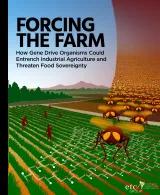Forcing The Farm
|
Introduction
The first attempt to use genetic engineering technologies on the farm involved altering common crops to be resistant to pests or weed-killers. This genetically modified (GM) crop approach ran into problems when many consumers didn’t buy GM foods and farmers found the promised benefits only materialised, if at all, in the shortterm. Now biotechnologists are contemplating a new strategy – to engineer newly developed invasive forms of genetic modifications to control insects, weeds and create new monopolies. Their plan is to use what has been dubbed a gene drive or ‘genetic forcer’ (see Box 1). Experiments with Gene Drive Organisms (GDOs) are aimed at designing creatures that automatically spread their engineered genes across whole habitats and ecosystems. They could, it is claimed, make some of our key agricultural pests extinct, reduce the need for pesticides and speed up plant breeding programmes. According to some of their proponents, gene drives could even be compatible with non-GMO and organic farming.
Half a century ago, bioscientists made the first deliberate snip in the genetic code of a living organism. By developing techniques to remove and insert sections of DNA ribbon, they launched a new phase in the industrialisation of life that has already begun to modify food, trade, land use, livelihoods, cultures and the genetic characteristics of the living world. The uptake by farmers of genetically modified organisms (GMOs), often without their fully informed consent and usually with mixed results, still makes billions of dollars for huge agrichemical corporations, such as Monsanto (now Bayer) and Syngenta (now Sinochem-ChemChina). More recently, however, uptake of GMOs has levelled off as the predicted risks have become evident, such as the intensification of the treadmill of increased use of toxic chemicals. With the arrival of so-called ‘gene editing’ techniques, and particularly what their proponents call ‘gene drives,’ Big Ag is shifting strategy and hopes to pick up the pace once again. Gene drive organisms (GDOs) are organisms that are supposed to reliably force one or more genetic traits onto future generations of their own species. The term for gene drives used by French scientists, ‘Forçage Génétique’ (genetic forcer) makes the intention clear: to force a human-crafted genetic change through an entire population or even an entire species. If they work, and that is not guaranteed at present, GDOs could accelerate the distribution of corporate-engineered genes from the lab to the rest of the living world at dizzying speed and in a potentially irreversible process. As this powerful technique has burst upon science, handmaidens of the biotech industry have worked to spread promises that GDOs can be harnessed for the common good – from grand dreams of stopping malaria to saving seabird eggs from rodents. However, the area of endeavour most likely to be impacted by the gene drive invention, with potentially dramatic consequences, has barely been whispered: agriculture and fisheries – the way we feed ourselves – could be fundamentally transformed by gene drives. In fact, for all the rhetoric of using gene drives ‘in the wild,’ the industrial farm may prove to be the landscape where gene drives first make their impact. Though unproven outside a few lab experiments, this technology is so potentially powerful and disruptive that Big Ag cannot afford not to undertake research on its potential. Moreover, gene drives offer agribusiness new potential opportunities to generate income from the problems faced by farmers.
The foundational patents for gene drives are largely written with agricultural applications in mind. One of the first two start-up companies working on gene drives (Agragene) is focused specifically on agriculture. Agri-giants with investments in the underlying gene editing technology such as Bayer, Syngenta-Chemchina and Corteva (Dow/DuPont) have been quietly lobbying policymakers. Crop commodity groups are becoming bolder, funnelling public and private dollars into agricultural gene drive experiments. Agricultural players and public labs are joining hands to develop agri-applications. Despite these tell-tale signs, almost no one in food and farm policy fora has yet discussed GDOs in public. This report is an attempt to correct that omission, arguing that the technology should not applied without a full process of informed public consent. The absence of agriculture in discussions of gene drives to date is not an oversight. Mindful of the strong global opposition to genetic engineering in the food and agriculture sectors, promoters of this technology have stage-managed which of the narrowly-framed applications should be announced to the public and policymakers first so that proposals with greater likelihood of public support (those involving medical or conservation applications) lead and shape the public reception of the technology.
Product details
Table of contents
- Introduction
- A technical-fix déjà vu
- Behind rare birds and woolly mammoths — How Big Ag hides its role
- Gene drive visions warp the future of farming
- A technology out of control?
- Acting ethically in a governance vacuum
